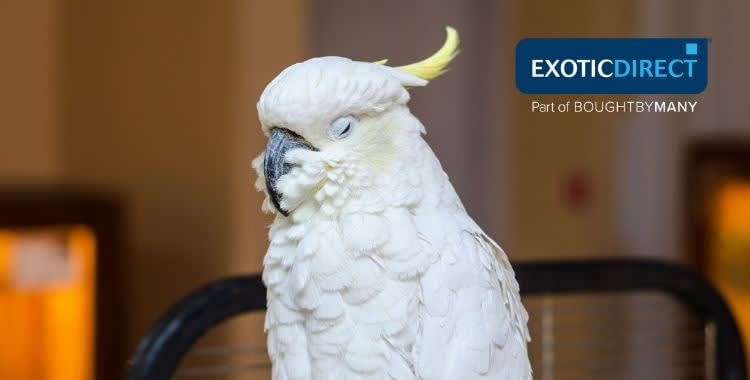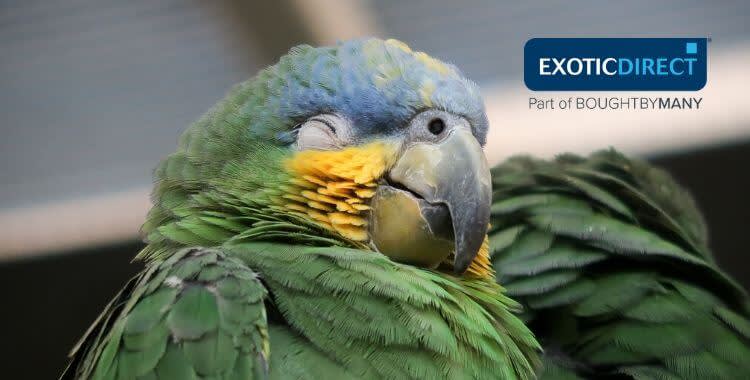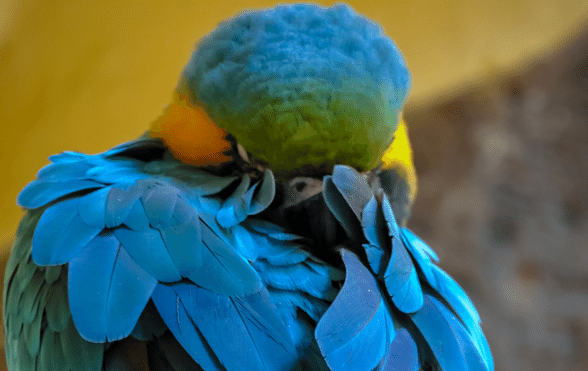A 12 hour sleep cycle is the norm for many parrots. How you can achieve this in the best possible way for your parrot, and you?
Is your parrot insured? Get a quote for up to £5,000 of vet fee cover, death and theft cover | We’ve been insuring exotic pets since 1996 | Check out our customer reviews on Feefo.
Which sleeping pattern is right for your bird? Broadly speaking most parrots are tropical animals. In the tropics day and night are 12 hours each. Dusk only lasts a few minutes.
Jump to: How long do pet parrots sleep? | Adjusting your parrot’s sleep schedule | Where should your parrot sleep? | Should you sleep with your parrot? | Parrot sleeping positions | Light cycles and reproduction behaviours | Sleeping too much and sleep deprivation
A wild parrots’ sleep pattern is that they go to roost just before sunset and wake at dawn. This means they live a 24-hour cycle of 12 hours sleeping, and 12 hours awake.
A few species live further away from equatorial regions and even fewer in temperate areas. Parrots living further away from the equator have slightly different habits, sleeping longer in winter months and shorter in summer months.
Australian parrots can live successfully within a wide range of temperatures so can be an example of both sleep cycles.
Following the pattern of parrots originating from the tropics a 12 hour 6am to 6pm span is closest to nature.
As a parrot pet owner, this may not suit your lifestyle if evening is the best time to interact with your parrot. However, parrots’ sleep patterns can be modified.

How long do pet parrots sleep?
African grey parrots, Macaws, Cockatoos, Alexandrines, Amazons, Eclectus, Caiques, Senegal’s, Cape parrots, Quakers, Ringneck and Red bellied parrots may need a 12-hour day/night cycle as they originate from the tropics.
Species from one of the more temperate regions or non-tropical areas like the Kea, Australian parakeets and Ringnecks who have adapted to a temperate zone, may need 10 hours of light and 14 hours of darkness in the winter months.
This is reversed to 14 hours of light and 10 hours of dark in the summer.
And of course, baby birds need more sleep.
This means that carers may need to adjust how much light the parrots receive depending on the species.
Don Harris, DVM, an avian veterinarian in Florida says. “The further away their home range is from the equator, the more seasonal changes are going to be significant.”
However, following tropical dawn to dusk for our parrots won’t suit us all.
Many bird owners work all day and don’t get home until late afternoon/early evening.
In the tropics it is already dark. And in other parts of the world as winter creeps over us, the days are shorter.
So, if you are following a tropical sunset to sunrise schedule you won’t have time to interact with your birds.
You can adjust your parrot’s sleep cycle to suit your lifestyle, as long as it still follows the relevant number of hours.
Is your parrot insured? Get a quote for up to £5,000 of vet fee cover, death and theft cover | We’ve been insuring exotic pets since 1996 | Check out our customer reviews on Feefo.

How can you adjust your pet parrot’s sleep schedule?
You can keep your birds’ out of their cages or in contact with you during the evening hours. But then you should not expect them up very early in the morning.
You can cover the cage for 10 to 12 hours. Even if the sun rises early a parrot in a dark, quiet, curtained room can still sleep.
Is it a poor style of handling to interact with a bird after it has been put to bed? There isn’t a straight yes or no. To quote Susan Friedman “Each bird is a study of one.”
A particular parrot can wake up and play with you. Others won’t. They are clearly sleepy and if you do arouse them, you may find they are grumpy and out of sorts next day.
Individual parrots, although broadly adhering to their species profile can and do demonstrate differences in their reactions in our homes.
Here are some anecdotes from my flock
Artha my first grey was always happy to relate to people, myself or my husband Wal at any time.
In the evening she would become quieter and would sit on my knee and go to sleep, eyes closed while I watched TV or read.
Casper the second grey, early showed a different pattern. At that time, the greys lived in the conservatory but came into the sitting room to spend play time with us.
At 8 pm as if he was wearing a watch, young Casper would lift off and rapidly fly from the sitting room back to the conservatory and put himself to bed. His cage door was left open and he slept in a little cardboard box.
Now he is a mature bird, sitting on my knee at 10pm he will often tuck a leg up, close his eyes and fall asleep. It always feels like an honour when a bird consents to sleep on you.
Years later when Benni macaw joined the flock and was hand fed for a couple of months, I used to put him in his cage at 6pm. If I did not he would act like an overtired toddler and become nippy.
My two macaws Mina a Military Macaw and Benni are now 3 and 6 and have reacted differently to the same handling.
Put to bed at 6pm when youngsters, they now enjoy playtime in the sitting room most evenings – fairly rumbustious play at that.
By 9pm they will leave off playing and perch on the ceiling ropes and doze. When I am ready for bed, they both step up and go to sleep in the bird room. Neither of them has ever fallen asleep on my knees or shoulder.
Where should parrots sleep?
There are various alterations to try.
Sleep cage: A popular one is a sleep cage. A smaller cage that is used simply to put the bird to bed.
A sleep cage to be efficacious needs to be placed in a separate space from where family activities are happening, such as a quiet and dark room, spare room or laundry room.
One lively friend of mine with a noisy social life and a small flat puts her two lovebirds in a walk-in hall cupboard.
Many carers report their bird reminding them ‘night-night,’ when they are ready to go sleep.
It is good practice when it is awake to keep the parrot in the room where there is the most family interaction. Just as it is good practice to remove it to somewhere quiet and dark when it is bedtime.
Cage coverings: A cage cover is useful if there isn’t any suitable place for the bird to sleep in darkness, especially if you have to keep your bird in a room where the lights are kept on late at night. You can buy cage covers from Northern Parrots.
However, these are a matter of choice. I use them sparingly. If a bird is unwell or a young bird needs more sleep than other birds in the vicinity.
Sometimes a new bird is nervous, and the cage cover can calm her. Other companion owners use them habitually.
There’s no clear evidence that the use of a cover avoids or encourages night frights.
For some birds, such as cockatiels, complete darkness may cause problems with night frights, and it may be necessary to leave part of their cages uncovered and plug in a night light to allow them to see.
My avoidance of covers is based on the fact that wild birds are not in total darkness for most of the night.
Should you sleep with your parrot?
Some owners have let their parrot sleep in bed with them. I would strongly discourage the practice in case you roll over in the night. You probably won’t but why risk it?
And yes – an anecdote. I was told of a Jardine parrot that was squashed flat. He recovered, but I still wouldn’t encourage sleeping with your bird.
Some carers take the sleep cage into their room. This will be all right if you do not suffer any allergies from powder down.
Parrot sleeping positions
Standing up: The parrot will tuck one foot up into its body feathers. The tendon in the other leg locks around the branch so that the bird doesn’t fall off the perch. The one-legged bird is stable.
Tucking head into feathers: The second most common movement is to rotate and tuck the head into the neck feathers.
Reasons for this may be both head and tucked up leg receive warmth, also muscles in the tucked-up leg are rested. The sleeping bird is conserving body heat.
Birds use their feathers to generate heat and regulate body temperature. Most parrots have bare legs and feet absent of the covering of insulating feathers. I have wondered why parrots’ legs don’t show their age by wrinkling more.
Parrot sleeping habits
- Parrots talking or singing in sleep: I’ve never heard of this with adult parrots, but I have heard of captive bred love-birds chirping as they fall asleep.
- Sleeping hanging forward: This is something I haven’t seen
- Swollen crop after sleeping: The crop should be full before sleeping and should be empty when it wakes up. If your bird’s crop is swollen after a long sleep you’ll need to investigate this further.
How dark and light cycles influence the reproductive system
You may also want to modify the light/dark cycles, depending on whether you want to encourage or discourage “breeding mode” in your birds.
Most owners are not breeding parrots and for them the problem is an unpaired bird that exhibits breeding behaviour.
This varies depending on species and there is a huge variation in the behaviour of individual birds.
Amazons have possibly the worst reputation for becoming aggressive in their main season.
Biting is a problem in both sexually mature Amazons and Cockatoos, while Cockatiels can resort to excessive egg laying. Reproductive hormones all play a significant part in this behaviour.
To help reduce the birds hormone level and control behaviour, you can reduce the light exposure down to 8-10 hours a day, simulating an extended night time.
Try using black-out curtains and cage covers to provide this artificial darkness. You’ll also need to move the bird into a quiet room, to help it to sleep.
The behaviour may take a while to reduce, up to a few weeks. Once this happens, you can begin to gradually return to a normal light/night schedule.
This method won’t work for all birds however. Ken Welle an American vet says, “For birds from temperate to polar regions, photoperiod is the most important influence on reproduction. But the closer to the equator the bird is from, the less influence it may have.”
If you have time to read the marvellous book about Tiko a red lored amazon by Joanna Burger, she describes in fascinating detail how when Tiko was in breeding moded, Joanna and her husband had to change their life style.
Tiko considered Joanna his mate and would attack her husband during that period. When not in breeding mode, he was a delight to both of them.
If you want a pair to breed then allowing them from 10 to 16 hours of light daily will encourage breeding behaviour.
Parrots who sleep a lot
Parrots who sleep more than 12 hours in a day may do so from a variety causes some benign – some less so.
A mature parrot sleeping on the floor of her cage is a serious warning sign that something is wrong.
If the feathers are fluffed up as well, a visit to the vet is needed.
The same applies if the parrot falls off its perch. These are abnormal signs.
Sleep deprivation in parrots
Some problems that might be exacerbated by lack of sleep could be feather plucking, excessive screaming, aggression and excessive fear.
A home-made effort to solve this would be to ensure the parrot has between 10- 12 hours of sleeping in a safe place.
There should be no fear of predators like humans bumbling about, noise or strong light.
If you can do that and after 10 to 14 days there’s no improvement in the unwanted symptom, you can eliminate lack of sleep from one of the causes.
Benefits of Natural Sunlight or UV Lighting
And finally, you should consider what type of light your bird is exposed to.
You should try to give your pet birds’ daily exposure to UV rays emitted by the sun. Sunlight through window glass does not convey these benefits.
Being outdoors also bestows psychological benefits which is why so many us build an aviary or close in a patio.
An aviary also needs shelter either partially roofed or greenery, plant bird-safe trees or cut branches.
If you watch aviary birds’ they will on occasion take sunbaths and then sit in the shade as they would do in their native forests.
Vets agree that several hours a day of exposure to an outdoor environment conveys health benefits.
Some of these can be imitated by purchasing UV lighting for the cage or bird-room. Although there is no real substitute for natural UV and fresh air.
Naturally not everyone is able to get their bird outside, and in the winter it can be even harder. You can buy UV lights and equipment from Northern Parrots.
If you do take your bird outside, remember to place a harness on her, to ensure she’s safe. Again, harnesses can be purchased from Northern parrots.
Thought about parrot insurance? Get a quote for up to £5,000 of vet fee cover, death and theft cover | We’ve been insuring exotic pets since 1996 | Check out our customer reviews on Feefo.

